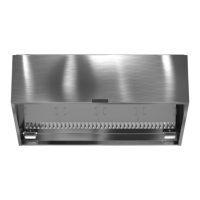Kitchen Hoods • Type I and Type II20
Perforated Face Supply or External Supply
Plenum - Rotating Vane Method
1. Hood set up.
Turn on both exhaust and supply air. If the make-up
air unit has temperature control, it should be used to
keep the supply air at the desired room discharge air
temperature.
2. Measure velocities.
Divide the first perforated face panel or air supply
plenum perforated panel into a grid of equal areas,
each approximately 4 in. (101.6 mm) square.
Measure the velocity at the center of each grid
area. A digital 2.75 in. (69.85 mm) rotating vane
anemometer or equivalent is suggested. The center
of the anemometer should be held tight to the
face of the panel. Both squareness and distance
are important for accuracy. Calculate the average
velocity of the panel.
3. Measure the length and height of the perforated
panel.
Filter Readings (ft/min.)
260 250 255 260 250 255 265
270 275 270 280 265 265 270
290 285 280 280 275 290 295
285 275 280 260 270 265 260
Filter Readings (m/hr)
4755 4572 4663 4755 4572 4663 4846
4938 5029 4938 5121 4846 4846 4938
5304 5212 5121 5121 5029 5304 5395
5212 5029 5121 4755 4938 4846 4755
Total system volume = (Panel 1 Volume) + (Panel 2 Volume) + (Panel 3 Volume)
(Imperial)
= 606.4 + 614.3 + 593.8 = 1814.5 cfm
(Metric)
= 1029 + 1044 + 1009 = 3082 m
3
/hr
Measure length and height. 28 inches (.711 m) long perforated panel by 16 inches (.406 m) high
Volume for one panel = Conversion Factor x Average Velocity x Length x Height
(Imperial)
= 0.005 x 270.7 ft/min. x 28 x 16 = 606.4 cfm
(Metric)
= 0.72 x 4951 m/hr x .711 x .406 = 1029 m
3
/hr
Example: Face supply hood with three 28 inch (.711 m) by 16 inch (.406 m) perforated panels
Measured velocities in ft/min. for one perforated panel
Average Velocity =
Sum of Velocity Readings
Number of Readings
(Imperial)
=
260 + 250 + ... + 265 + 260
28
= 270.7 ft/min.
(Metric)
=
4755 + 4572 + ... + 4846 + 4755
28
= 4951 m/hr
4. Calculate the perforated panel volume using the
following formula:
CFM = avg. velocity x length (in.) x height (in.) x 0.005
m
3
/hr = avg. velocity x length (m) x height (m) x 0.72
5. Calculate the system’s volume by repeating the
process for the remaining perforated panels and
adding the individual panel volumes together.

